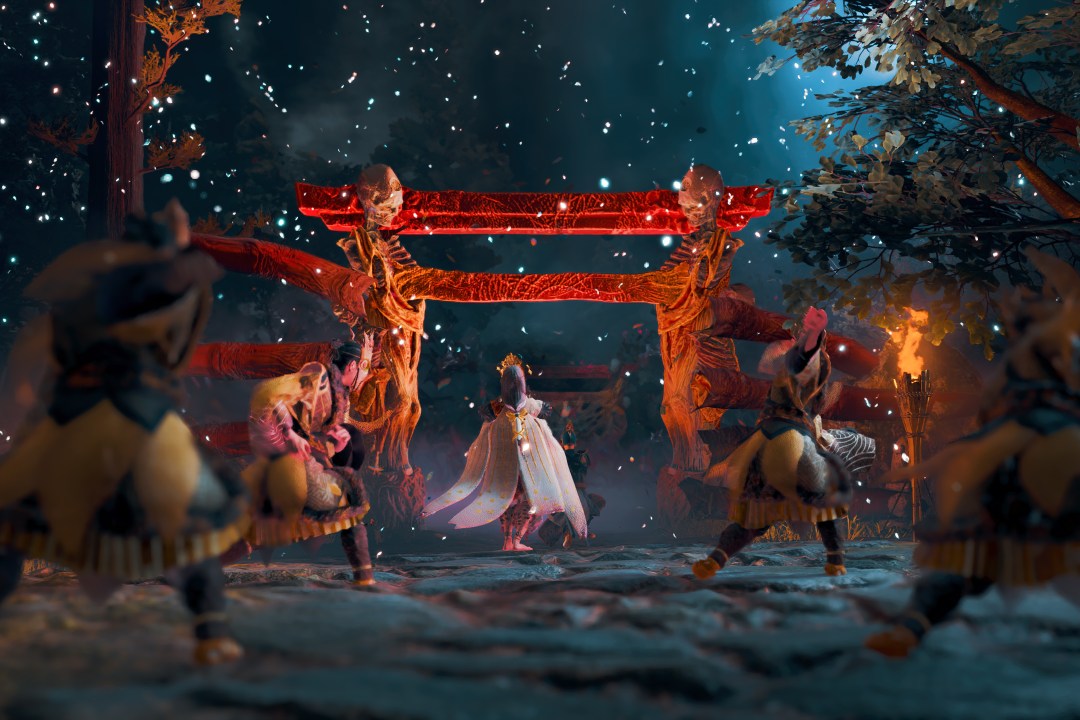Kunitsu-Gami: Path of the Goddess review – simply divine
A gorgeous and thoroughly engaging oddity you just don’t expect from major publishers anymore.

Stuff Verdict
Capcom’s curious blend of action, real-time strategy and tower defence is one of the most original games you’ll play all year
Pros
- Amazing blend of strategy and action
- Beautiful Japanese-inspired visuals
- Very replayable challenges and village rebuilding
- Flexible upgrade and customisation options
Cons
- Revisiting villages could be faster
Introduction
You’ve got to give kudos to a developer that takes some leftfield swings instead of just relying on established franchises. This isn’t Capcom’s first quirky original title to embrace Japanese mysticism and ancient culture – but unlike the criminally overlooked 2006 adventure Okami, an Xbox Game Pass release should mean Kunitsu-Gami: Path of the Goddess isn’t fated to sink into obscurity.
From its colourful creatures and costumes to a pastoral message of healing nature, Kunitsu-Gami is proudly Japanese in its inspirations. You play as masked swordsman Soh, on a mission to help the divine maiden Yoshiro purge and cleanse a mountain of an evil ‘defilement’. But beyond that Link/Zelda dynamic, you also need to rely on villagers to help you beat back overwhelming hordes of monsters called Seethe, turning this into a curious blend of action, real-time strategy and tower defence.
To put it simply, there’s really nothing else like it. The result is one of the most original games you’ll play this year.
In this together


During the day Yoshiro moves towards Torii gates, along paths you’ve carved out for her. She dances forwards slower than a snail, but you’re often too busy to notice, purging defilement around the village, rescuing cocooned villagers, and assigning them jobs. When night falls, everyone bands together to fight off monsters that emerge from the gate until the sun rises again. Rinse and repeat until Yoshiro cleanses the gate for good. Successive stages introduce new elements, or subvert it altogether: boss arenas where you command villagers to attack or defend en masse feel especially Pikmin-esque.
Within that set-up is a deft balance of strategic choices and tight time and resource management. Early on you have one key villager who can repair structures, weapons or traps around the village, but there’s also only so much he can do during the day; you’ll have to prioritise what’s most useful. Crystal orbs earned from combat can be spent assigning roles to villagers, with certain jobs costing more than others. You’ll need to budget, while keeping a surplus in case you suddenly need healers or ranged attackers midway through a stage.
A rewind function would’ve been nice, but auto-saves that occur with every new day or evening are the next best thing, and beat having to restart a stage from the beginning. Being able to reset Soh’s abilities or villagers’ roles means you can focus on maxing out one job’s upgrade path for a specific stage or boss fight, then revert to something more balanced later.
Back to nature


Kunitsu-Gami is the latest game to use Capcom’s in-house RE Engine, and it’s a proper stunner. In one early sequence it’s quite literally kaleidoscopic, while Soh’s ceremonial dance-inspired sword combat leaves a trail of psychedelic colours that almost feels like you’re waving fireworks around. Yoshiro’s dance that purges the defilement’s source can be skipped, but it honestly never gets dull to watch the riotous festival vibe each time.
That virtually all the human characters are wearing masks means this mid-budget game doesn’t have to worry about photorealistic faces. There’s real artistry in the mask designs, though, and the grotesque Seethe that are inspired by yokai from Japanese folklore. The one person whose face you do see, Yoshiro, provides the story’s emotional core as you see how purging the defilement starts taking its toll. She’s neither a damsel or romantic interest, though you can make her happy with a variety of sumptuous Japanese sweets collected as you cleanse each village. Seeing her pick one up and have a nibble when you visit her at base camp is a lovely little touch while you save the game, upgrade your villagers or customise your other abilities at base.
These collectibles encourage you to repair the villages you’ve previously cleansed, with the more villagers you’ve saved the faster the rebuilding effort. Different structures require more villagers, and take multiple days to fix. It’s not a forced grind, with much of it happening behind the scenes while you play new missions – but you’ve got to remember to revisit each one. The to-ing and fro-ing between villages gets a little sluggish when you’d rather be getting on with the campaign.
The path goes on


Even without the base building element, you’re still looking at a well-paced story of around 10-15 hours, which provides something fresh for each stage. But Kunitsu-Gami has been made with replay value in mind, with optional challenges for each mission that you’re unlikely to have managed the first time out.
Some seem deliberately impossible at first, so it’s always great returning to an earlier mission after earning some new upgrades or jobs for your villagers. Talismans are an especially great way in subtly rebalancing things in your favour, though sometimes you have to weigh up the benefits of improving your villagers’ attack power at the expense of Soh’s. It’s even possible for more masochistic players to equip talismans that up the difficulty even more.
I got a lot out of the Tsuba Guards, which allow you to charge up an ultimate ability. Depending on your playstyle, this could be a decisive attack to damage and stun a boss, or give your nearby allies a much needed buff. If you get a game over, when retrying from the last checkpoint you also get the option to change your equipment loadout. Throw in New Game+ and you’ve got a package as generous as any of Capcom’s other tentpole blockbusters.
Kunitsu-Gami: Path of the Goddess verdict


It’s becoming rarer for big publishers to make games that feel genuinely fresh. But if you thought Capcom had just been resting on its laurels (albeit ones as flawless as Resident Evil 4 remake, Street Fighter 6 and Dragon’s Dogma 2), then think again. Kunitsu-Gami is really unlike anything else, with unique Japanese-inspired art direction being just the start; I haven’t even mentioned the boss fights with outrageous jazz numbers.
At the mid-range price of £40, Kunitsu-Gami isn’t just a bargain: it’s a true original, beautifully draped around challenging and replayable strategy gameplay fused with the same Capcom brand of satisfying action. It might be too eccentric for some, but given a chance this could be the best game you’ll play this summer.
Stuff Says…
Capcom’s curious blend of action, real-time strategy and tower defence is one of the most original games you’ll play all year
Pros
Amazing blend of strategy and action
Beautiful Japanese-inspired visuals
Very replayable challenges and village rebuilding
Flexible upgrade and customisation options
Cons
Revisiting villages could be faster

